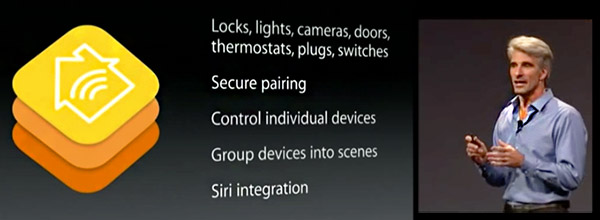Apple is preparing to launch an app called “Home” to act as an interface for setting up and managing smart devices that plug into its HomeKit framework, 9 to 5 Mac reported last week.
The Home app is expected to manage thermostats, smoke alarms, garage door openers, door locks, and other automated home tech.
Apple already has announced that some HomeKit products will be making their debut at this year’s WWDC, which will be held next month in San Francisco. It’s possible the Home app could be unveiled there as well.
However, Home appears to be in its early development stages.
The software has features for discovering and configuring devices, locating them in an on-screen virtual home, and using Apple TV as a device hub, as well as help screens to make setup of devices easier, 9 to 5 Mac reported, according to unnamed sources familiar with the app.
Apple did not respond to our request to comment for this story
If the Home app exists, that doesn’t necessarily mean it’s meant for consumer consumption. It could be restricted to Apple’s internal use. The company may plan to let consumers use apps from the App Store to control their home management and monitoring devices.
An Un-Apple Category
With HomeKit, Apple hopes to bring its trademark “it just works” magic to a very difficult realm.
“Making all this stuff work together is really hard,” said Bob O’Donnell, founder and chief analyst with Technalysis Research. “It requires a lot of tedious self setup and things that are very un-Apple like.”
“Apple figures that the only way it can solve this problem is by creating software that keeps the messy stuff in the background,” he told TechNewsWorld.
That will be fine for developers who want to play ball with Apple and HomeKit, but for many it will mean a brand new game.
“There are elements that you have to add to your device to do that, and not everyone will want to do it,” O’Donnell said, “so you’re going to have some devices that support HomeKit and some that won’t, and making that all work is going to be tough.”
HomeKit’s success could lie in which devices end up supporting it.
“Even if it has many devices, if it isn’t supported by the right devices, that could be a problem,” O’Donnell said.
Tapping Its Installed Base
Acceptance of HomeKit may be further along than meets the eye, however.
“At this point, we don’t know how many members of the home automation ecosystem are working with HomeKit, but I think even competitors like Nest, which is owned by Google, are integrating with HomeKit,” said Charles Golvin, founder of Abelian Research.
“The reason is, the installed base with iPhones and iPads is so significant that it’s a market that can’t be ignored,” he told TechNewsWorld.
“It’s a no-brainer for anybody in that ecosystem to incorporate HomeKit support,” Golvin added. “The opportunity to target an attractive customer base is inescapable.”
HomeKit is designed to accommodate a home automation market that’s very fragmented, because many consumers are approaching home automation that way. They may purchase an item for a single purpose — controlling heating and cooling with a smart thermostat — and later add something to do something else — a smart smoke detector, perhaps. HomeKit should make that kind of expansion seamless.
“There are many consumers who have taken that step in home automation, and the overlap of that customer base with people owning Apple products is significant,” Golvin noted. “So these device makers not only see a ready base of adopters within iOS, but also a mechanism for easily helping those customers take a subsequent step in home automation with the HomeKit platform.”






















































